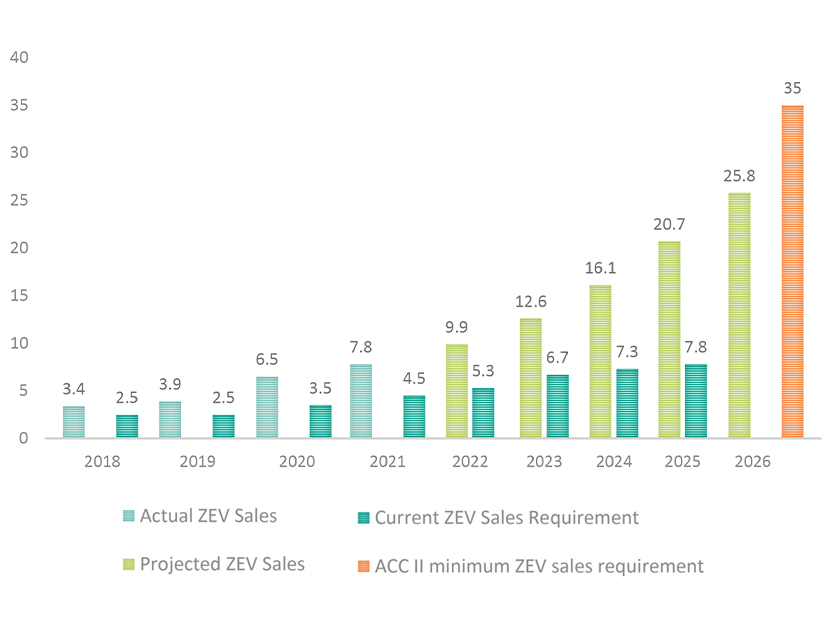Oregon regulators are racing to adopt by the end of the year a California rule requiring all new cars sold in the state to be zero-emission or plug-in hybrid by 2035.
Adoption this year would mean that the rule, known as Advanced Clean Cars II, would take effect starting with vehicle model year 2026. The regulation would require car manufacturers to provide an increasing percentage of ZEVs for sale each year, beginning with 35% in 2026.
The California Air Resources Board voted to adopt the regulation last week. (See Calif. Adopts Rule Banning Gas-powered Car Sales in 2035.)
In Oregon, the Department of Environmental Quality held its first meeting of the Advanced Clean Cars II Rule Advisory Committee on Tuesday. Rachel Sakata, a senior air quality planner at DEQ, said the agency expects to release the rule for formal public comment in September.
The proposal would then go to the Environmental Quality Commission for potential adoption in December, Sakata told the committee.
Oregon is one of 17 states that have adopted California’s current Advanced Clean Cars regulation, which covers new vehicles through model year 2025. Under the Clean Air Act, states may choose to follow federal vehicle emission standards or adopt regulations that are essentially the same as those of California.
There’s a rush to adopt the new Advanced Clean Cars II by the end of this year because of a two-year waiting period that’s required before the regulation can take effect. Model year 2026 vehicles will be released starting in 2025, Sakata noted.
Infrastructure Concerns
Committee member Greg Remensperger, executive vice president of the Oregon Auto Dealers Association, said dealers support the transition to electric vehicles, although some have concerns about how quickly they’ll face the 100% sales requirement.
Remensperger said he will recommend a mid-term review of ACC II to see if the pieces needed for the program’s success are falling into place.
“[If] we implement the rules as stated and the availability isn’t there or the cost is too expensive or the infrastructure is not there to support it, it’s just going to drive consumers to leave the state to buy … the ICE vehicle and bring it back into Oregon,” Remensperger said.
Not everyone at the meeting was on board with the proposed ACC II regulation. Oregon Rep. David Brock Smith (R) said the proposal is “not well thought out” when it comes to factors such as having sufficient transmission and capacity.
“That is why it’s the legislature that should be directing these policies and not rulemaking through agencies,” said Smith, adding that he will propose legislation to “unwind” the rulemaking work.
Jumping to 35%
The current Advanced Clean Cars regulation, which Oregon has adopted, also includes a ZEV sales requirement that increases each year, topping off at 22% for model year 2025.
However, ZEV credits are calculated differently in the current regulation as compared to ACC II. In the existing system, credits are based on factors, including the electric range of a vehicle, with some ZEV models receiving multiple credits per vehicle.
ACC II will use ZEV “values” rather than credits. One zero-emission vehicle will equal one value.
Despite the differences, Sakata acknowledged it will be a “jump” for car manufacturers to meet the 35% ZEV requirement in 2026. But automakers will have a variety of tools to help close the gap, she said. Those include the ability to carry over credits earned under the current Advanced Clean Cars rules, an early credit system and a system for transferring credits between ACC II states.
And under ACC II, manufacturers can meet up to 20% of their ZEV requirement with plug-in hybrid vehicles.
In addition, manufacturers can take advantage of voluntary environmental justice credits, which will be awarded for actions such as providing low-priced ZEVs for sale in model years 2026 through 2028. The ZEVs or PHEVs must have an MSRP of $20,275 or less for passenger cars and $26,670 or less for light-duty trucks.
States adopting California’s ACC II rule will have some flexibility in implementing environmental justice credits. That’s a topic on which the advisory committee will provide input.
Moving Forward in 2022
Oregon is one of four states, along with Washington, Vermont and Massachusetts, that have said they intend to adopt ACC II by the end of this year, according to a blog post from the Natural Resources Defense Council. Several other states may follow suit in 2023.
For example, Nevada published an initial draft regulation on June 30 as a first step toward adoption of ACC II. The Nevada Division of Environmental Protection plans to analyze potential costs and benefits of the regulation and receive public comment before bringing it to the State Environmental Commission for possible adoption next year.
NDEP expects to release more details on the process in coming weeks, the agency told NetZero Insider.
In Oregon, the Advanced Clean Cars II Rule Advisory Committee will hold a second meeting on Sept. 20 to review statements of fiscal, economic and racial equity impacts of the rule.
Informal comments may be submitted to the committee until Sept. 7 at noon. More information on the ACC II rulemaking is here.

